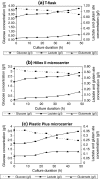Comparing BRIN-BD11 culture producing insulin using different type of microcarriers
- PMID: 20953703
- PMCID: PMC2993864
- DOI: 10.1007/s10616-010-9294-9
Comparing BRIN-BD11 culture producing insulin using different type of microcarriers
Abstract
This research was conducted to examine the growth profile, growth kinetics, and insulin-secretory responsiveness of BRIN-BD11 cells grown in optimized medium on different types of microcarriers (MCs). Comparisons were made on modified polystyrene (Hillex(®) II) and crosslinked polystyrene Plastic Plus (PP) from Solohill Engineering. The cell line producing insulin was cultured in a 25 cm(2) T-flask as control while MCs based culture was implemented in a stirred tank bioreactor with 1 L working volume. For each culture type, the viable cell number, glucose, lactate, glutamate, and insulin concentrations were measured and compared. Maximum viable cell number was obtained at 1.47 × 10(5) cell/mL for PP microcarrier (PPMCs) culture, 1.35 × 10(5) cell/mL Hillex(®) II (HIIMCs) culture and 0.95 × 10(5) cell/mL for T-flask culture, respectively. The highest insulin concentration has been produced in PPMCs culture (5.31 mg/L) compared to HIIMCs culture (2.01 mg/L) and T-flask culture (1.99 mg/L). Therefore overall observation suggested that PPMCs was likely preferred to be used for BRIN-BD11 cell culture as compared with Hillex(®) II MCs.
Figures





Similar articles
-
Culture and function of electrofusion-derived clonal insulin-secreting cells immobilized on solid and macroporous microcarrier beads.Biosci Rep. 2000 Jun;20(3):167-76. doi: 10.1023/a:1005563418884. Biosci Rep. 2000. PMID: 11095116
-
Characterization of a novel glucose-responsive insulin-secreting cell line, BRIN-BD11, produced by electrofusion.Diabetes. 1996 Aug;45(8):1132-40. doi: 10.2337/diab.45.8.1132. Diabetes. 1996. PMID: 8690162
-
Engineering cultured insulin-secreting pancreatic B-cell lines.J Mol Med (Berl). 1999 Jan;77(1):235-43. doi: 10.1007/s001090050344. J Mol Med (Berl). 1999. PMID: 9930971 Review.
-
Costus pictus D. Don leaf extract stimulates GLP-1 secretion from GLUTag L-cells and has cytoprotective effects in BRIN-BD11 β-cells.J Ethnopharmacol. 2020 Oct 5;260:112970. doi: 10.1016/j.jep.2020.112970. Epub 2020 May 16. J Ethnopharmacol. 2020. PMID: 32422353
-
Influence of Microenvironment on Mesenchymal Stem Cell Therapeutic Potency: From Planar Culture to Microcarriers.Front Bioeng Biotechnol. 2020 Jun 24;8:640. doi: 10.3389/fbioe.2020.00640. eCollection 2020. Front Bioeng Biotechnol. 2020. PMID: 32671039 Free PMC article. Review.
Cited by
-
Three-Dimensional Bioreactor Technologies for the Cocultivation of Human Mesenchymal Stem/Stromal Cells and Beta Cells.Stem Cells Int. 2018 Mar 14;2018:2547098. doi: 10.1155/2018/2547098. eCollection 2018. Stem Cells Int. 2018. PMID: 29731775 Free PMC article. Review.
References
-
- Bluml G. Microcarrier cell culture technology. In: Portner R, editor. Animal cell biotechnology: methods and protocols. New Jersey: Humana Press; 2007. pp. 149–179.
LinkOut - more resources
Full Text Sources
Miscellaneous

